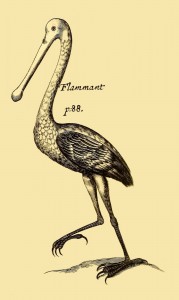Flammant – Flamingo
FLAMMANS,
The Ponds and fenny places which are not much frequen-
ted are the retreats of several great and beautiful Birds
about the bigness of wild Geese, and of the fame figure with
thofe which the Dutch call Lepelaer, from the form of their
beak, which hath the resemblance of a spoon: They have long
necks, and their legs are of such length, that their bodies are
about three foot from the ground: But they differ as to colour
inasmuch as when they are young their feathers are
white as they grow it becomes of a murrey colour, and when
they are old of a bright carnation : from which colour the
French took occasion to call them flammans : There are of
these Birds seen neer Montpelier in France, which have the lower
part of their body and under their wings of a carnation colour,
the upper part black; there are in like manner in theae
Islands some that have a mixture of black and white feathers in
their wings.
They are seldom seen but in great companies , and their
hearing and smelling is so perfect that they smell the Huntsmen
and Fire-arms at a great distance : To avoid all surprises
they pitch in open places, and in the midst of Fens, whence
they may at a great diftance perceive their enemies ; and there
is always one of the party upon the guard while the rest are
searching in the waters for their livelihood ; and as soon as he
hears the least noise, or perceives a man, he takes his flight, and
gives a cry for a signal to the reft to follow him : when the
Hunts-men who frequent Hispaniola would kill some of these
Birds, which are there very common, they take the wind of
them, that the smell of the powder may not easily be carry’d
to them, then they cover themselves with an Ox-hide and
creep on their hands and feet till they come to a place whence
they may be sure to kill. By this fleight these Birds who
are accustomed to see the wiid Oxen that come out of the
Mountains to the watering-places below become the prey of
the Huntsmen. They are commonly fat, and a delicate
meat: Thar skins are kept, which are cover’d with a soft
down, to be put to the same uses as those of Swans and
Vultures.

